Dive Details
Location
Logged dive number
1724
Date
Sunday 10 November 2019
Time
8:08am - 9:50am
Seas
Slight surge
Visibility
3 to 5 metres
Duration
101 minutes
Surface interval
Maximum depth
14.9 m
Average depth
12.2 m
Water temperature
17°C
Dive Profile from Garmin Descent Mk1

Tides at Botany Bay AEDT
Note that tides at dive site may vary from above location.
Low
1:30am
0.43m
High
7:47am
1.54m
Low
1:58pm
0.50m
High
7:57pm
1.47m
Details
I had planned to dive at The Monument yesterday but some other things came up so today would be my only dive for the weekend. The tides were not great and reports had the visibility being down. There was a southerly swell forecast so The Steps was the most logical choice for an early dive on the outgoing tide.
Conditions looked very good when I arrived at The Steps with barely any swell and the surface water looked clear.
I geared up and jumped in at The Steps around 20 minutes after high tide. I swam out on the surface before descending to the boulders and then swam to the kelp. The visibility was only 3 to 5 metres and there was a lot of suspended particulate matter. I hoped the visibility would improve as I headed towards Big Rock. There was negligible current and surge. The water temperature was around 17°C.
I looked around the rocks in front of the entry/exit for anglerfishes but found none. I then headed for the sand line and followed it towards Big Rock.
Just after the first large rock on the sand line (where the seahorses were last year) I started to look for the male Weedy Seadragon that had eggs two weeks ago. I suspected he'd no longer have eggs as they were nearly done when I last saw him. I managed to find him and sure enough his tail was clean. I took my usual ID photographs as well as shots of his clean tail.
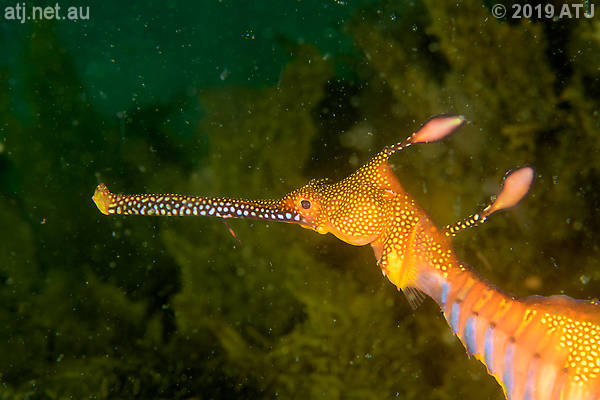
Weedy Seadragon, Phyllopteryx taeniolatus. 12.4m.
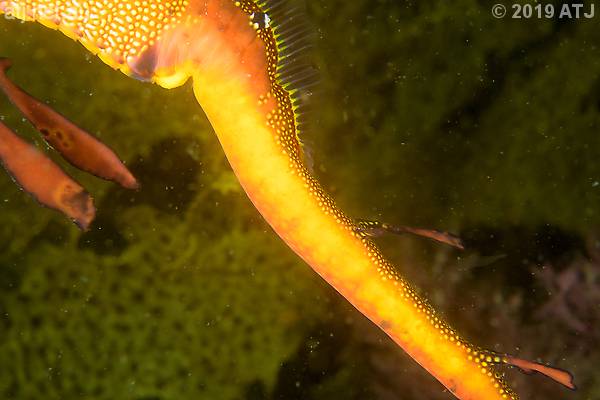
The tail of a male Weedy Seadragon, Phyllopteryx taeniolatus, without eggs. 12.4 m.
I continued along the sand line to Pipefishes Hole. Just before I looked in the hole I noticed another orange scallop with blue eyes just above the hole. I have since found out they are called Doughboy Scallops, Mimachlamys asperrima.
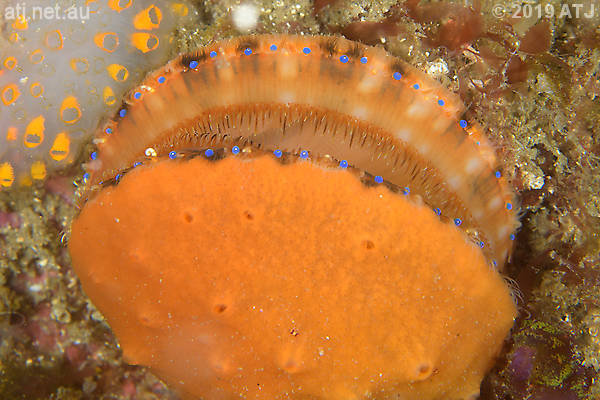
Doughboy Scallop, Mimachlamys asperrima. 12.8m.
I looked in the hole and saw one of the Upside-down Pipefish and a Sawtooth Pipefish. I wasn't able to get any good shots of them because they were both so far back in the hole.
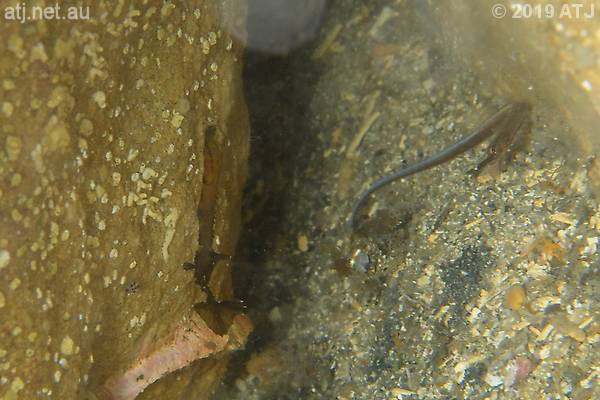
Juvenile Upside-down pipefish, Heraldia nocturna, and Sawtooth Pipefish, Maroubra perserrata. 13.3m.
I headed past Pipefishes Hole and looked in the kelp for the large juvenile Weedy Seadragon that I first saw with Georgia in March. I found it.
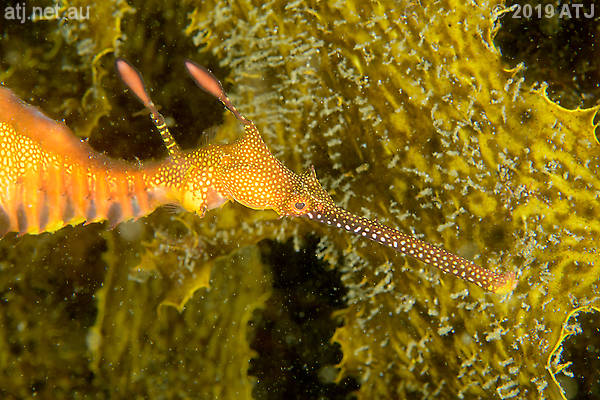
Weedy Seadragon, Phyllopteryx taeniolatus. 13.4m.
I followed the sand line towards Little Big Rock and checked out the rocks for anglerfishes along the way. I swam up a bit from the sand line as I approached Little Big Rock and looked on the rock for Dama's Sawtooth Pipefish. It's been months since I last saw them but I'm ever hopeful they will return. I couldn't see them.
I swam up to the large rock behind Little Big Rock where the Pot-bellied Seahorses live. I spotted "David" in the white honeycomb sponge on the lower rock. I found "George" in the sea tulips on the lower side of the rock. He was on the move and stopped on an open area. I then hunted around the rock for "Skye". I didn't see her on my first pass but found her on the opposite side of the rock from "George". I was quite pleased that I'd already seen 4 species of syngnathid and there was still a strong possibility of pygmy pipehorses.
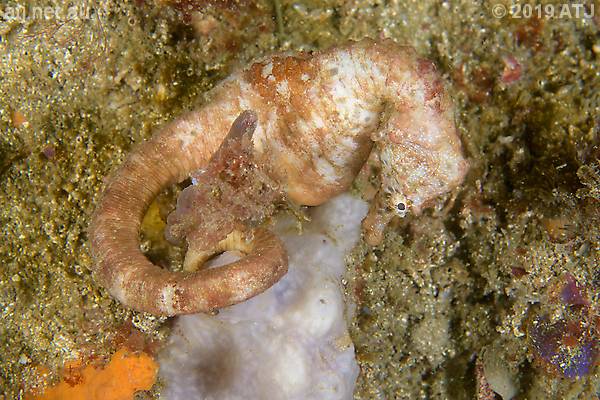
Male Pot-bellied Seahorse, Hippocampus abdominalis, ("George"). 12.2m.

Female Pot-Bellied Seahorse, Hippocampus abdominalis, ("Skye"). 11.9m.

Male Pot-bellied Seahorse, Hippocampus abdominalis, ("David"). 12.5m.
I headed along the top of the reef towards the basket star. I had a brief look for the black Painted Anglerfish on the rock where I'd last seen it. It wasn't there but then it hadn't been there two weeks ago. (After the dive I found out that Dimitry found it and said it was closer to the sand line.)
I continued to the basket star and then looked around the rocks for the orange Red-fingered Anglerfish. I couldn't find it or any other anglerfishes.
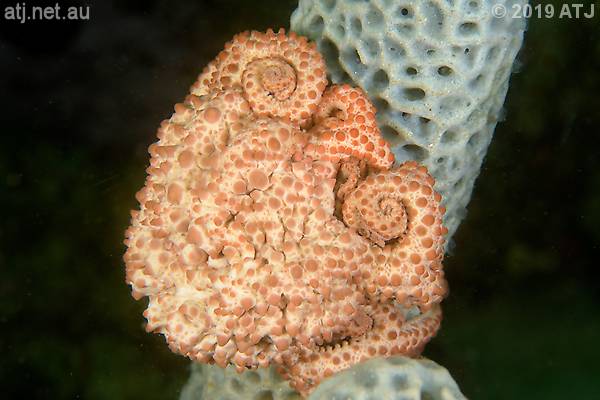
Basket star, Astrosierra amblyconus. 12.2m.

Basket star, Astrosierra amblyconus. 12.3m.
I headed down to Diversity Rock and looked for the Miamira magnifica nudibranch. I found it on the same small rock I'd seen it on two weeks ago. I'm finding it more quickly now I know how small it is.
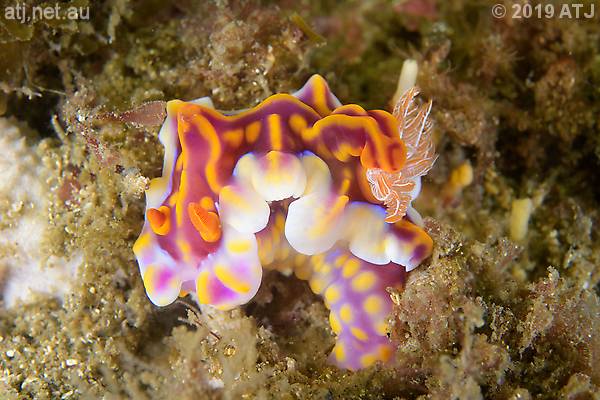
Nudibranch, Miamira magnifica. 14m.
I swam mid-reef towards Big Rock. I checked out the rocks as I swam for pygmy pipehorses. I was rewarded with a bright red male (IL2019111001) on a rock not far from where the large white male had been earlier in the year. I took some photographs of him and looked around for a female but could not find one. There was a dark red sponge on the same rock and I spotted some Icilius sp amphipods. I took some photographs. As I was about to swim off I noticed a small Common Sydney Octopus.

Male Sydney Pygmy Pipehorse, Idiotropiscis lumnitzeri, (IL2019111001). 13.5m.
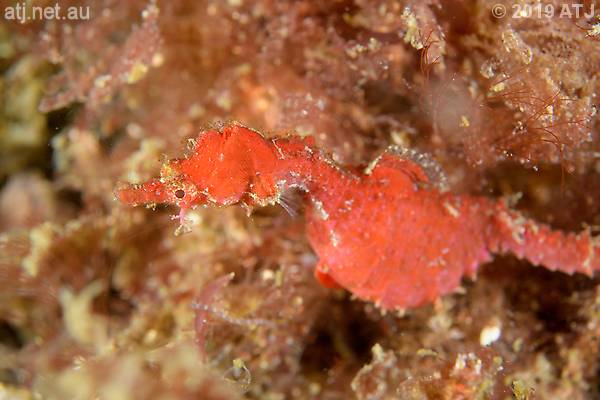
Male Sydney Pygmy Pipehorse, Idiotropiscis lumnitzeri, (IL2019111001). 13.6m.
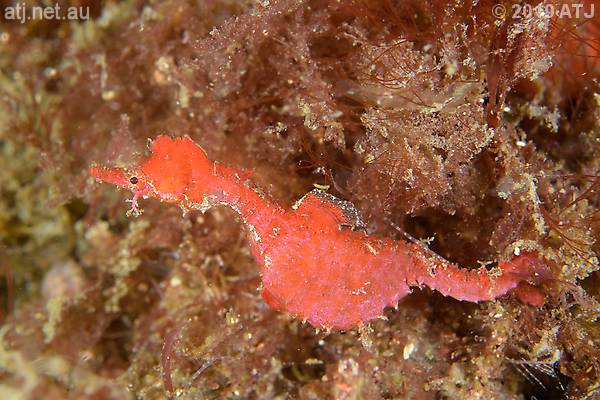
Male Sydney Pygmy Pipehorse, Idiotropiscis lumnitzeri, (IL2019111001). 13.6m.

Amphipod, Icilius sp. 13.1m.

Common Sydney Octopus, Octopus tetricus. 13.4m.
I continued mid-reef and looked for the rock with the pink female and male. I had a little trouble locating the rock from this direction and had to swim past it to get my bearings. I eventually found the rock and the pink female (IL2019100503) was out in the open. I searched for the pink male and found him (IL2019100601) hiding on the side of the rock. I looked around for the other male I'd seen 2 weeks ago but could not find him.

Female Sydney Pygmy Pipehorse, Idiotropiscis lumnitzeri, (IL2019100503). 13.4m.

Female Sydney Pygmy Pipehorse, Idiotropiscis lumnitzeri, (IL2019100503). 13.4m.
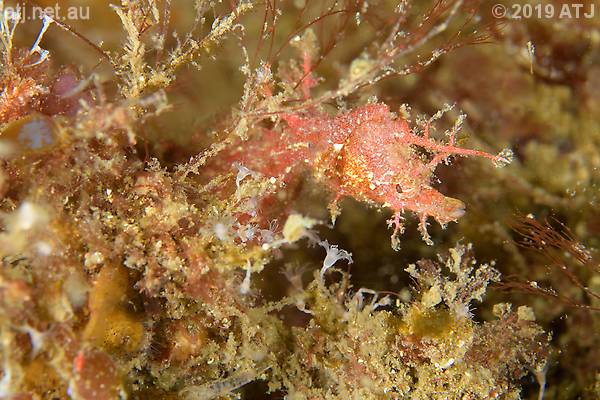
Male Sydney Pygmy Pipehorse, Idiotropiscis lumnitzeri, (IL2019100601). 13.5m.
I headed farther towards Big Rock and dropped down to the rock where the Doughboy Scallop has been. It was in its usual spot.
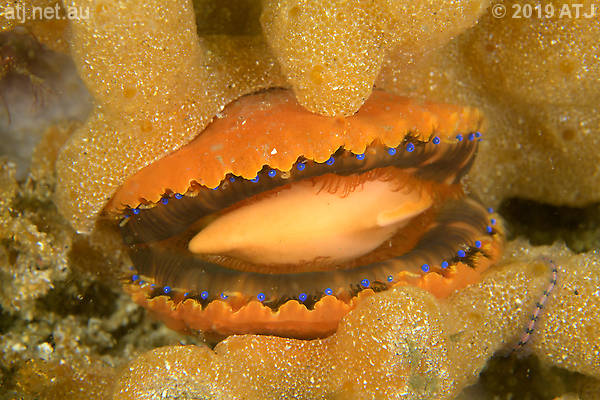
Doughboy Scallop, Mimachlamys asperrima. 14.1m.

Doughboy Scallop, Mimachlamys asperrima. 14.2m.
I swam to the long rock and looked for the male pygmy Cody had pointed out to me or the female I'd found 2 weeks ago. I first saw the male (IL2019100502) and then noticed the female (IL2019102702) close behind him.
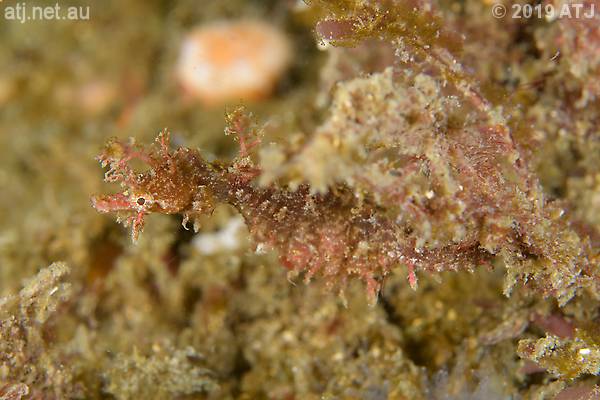
Male Sydney Pygmy Pipehorse, Idiotropiscis lumnitzeri, (IL2019100502). 14m.
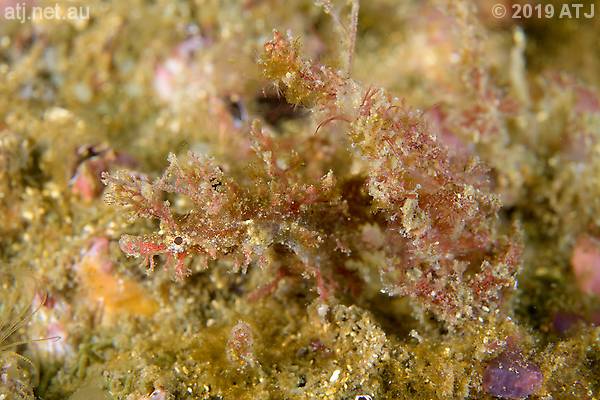
Female Sydney Pygmy Pipehorse, Idiotropiscis lumnitzeri, (IL2019102702). 13.9m.
I continued on towards Big Rock, looking at various rocks where I have seen pygmy pipehorses previously. I didn't find any. I swam up to the sponge where I have previously seen "Ouz", the yellow White's Seahorse. She wasn't in that sponge but I spotted her in a nearby sponge. This made 6 different species of syngnathid for the dive.

Female White's Seahorse, Hippocampus whitei, ("Ouz"). 13.9m.
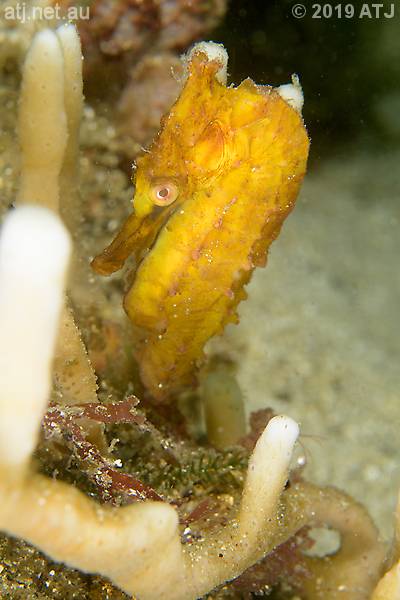
Female White's Seahorse, Hippocampus whitei, ("Ouz"). 14m.
I turned and headed back towards The Steps. I stopped at the pygmy pipehorses on the long rock and also the pink male and female pygmies.
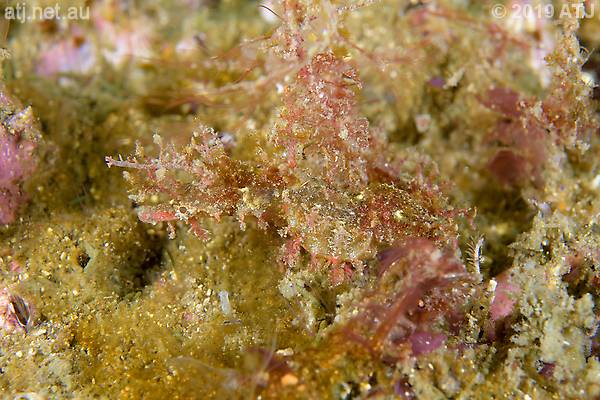
Female Sydney Pygmy Pipehorse, Idiotropiscis lumnitzeri, (IL2019102702). 13.9m.
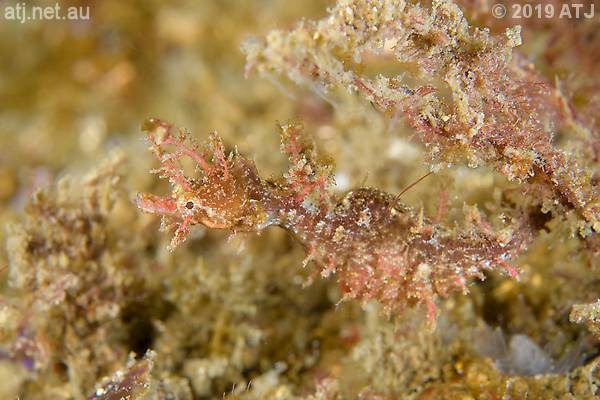
Male Sydney Pygmy Pipehorse, Idiotropiscis lumnitzeri, (IL2019100502). 13.9m.
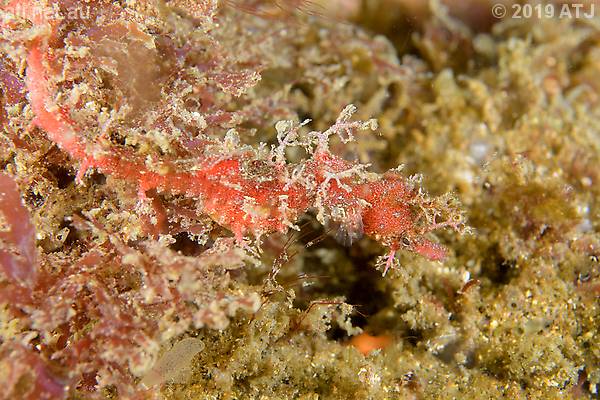
Female Sydney Pygmy Pipehorse, Idiotropiscis lumnitzeri, (IL2019100503). 13.3m.

Male Sydney Pygmy Pipehorse, Idiotropiscis lumnitzeri, (IL2019100601). 13.7m.
I stopped at the rock where I found the new red male pygmy pipehorse and had another look for a female but couldn't find her.

Male Sydney Pygmy Pipehorse, Idiotropiscis lumnitzeri, (IL2019111001). 13.4m.
I swam by the Miamira magnifica nudibranch and then had another look for the orange Red-fingered Anglerfish near the basket star. I spotted a flatworm crawling down one of the rocks.
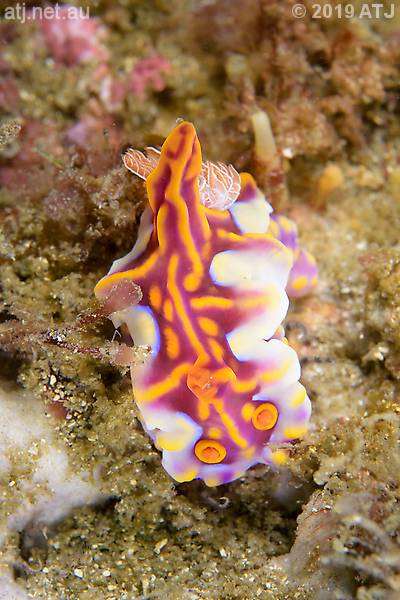
Nudibranch, Miamira magnifica. 13.8m.
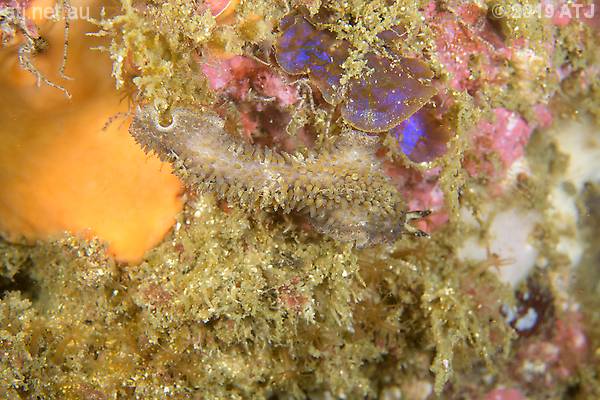
Flatworm. 11.9m.
I headed to the Pot-bellied Seahorses. I couldn't find "George" but "David" had moved to the grey sponge. "Skye" hadn't moved.
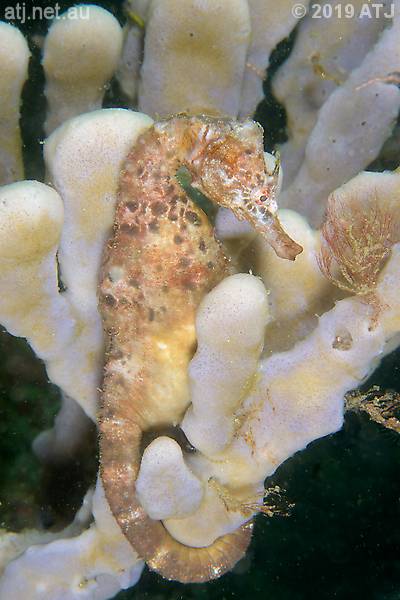
Male Pot-bellied Seahorse, Hippocampus abdominalis, (""). 12.2m.
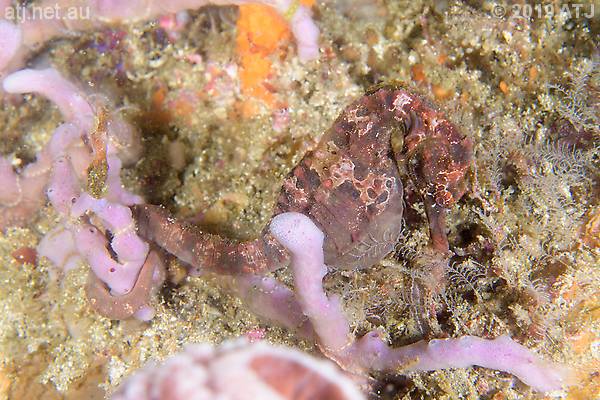
Female Pot-Bellied Seahorse, Hippocampus abdominalis, ("Skye"). 12m.
I swam along the top of the reef to Di's Rock, looking for anglerfishes along the way. From here I dropped down to Pipefishes Hole. There was a Sawtooth Pipefish and an Upside-down Pipefish visible in the hole.
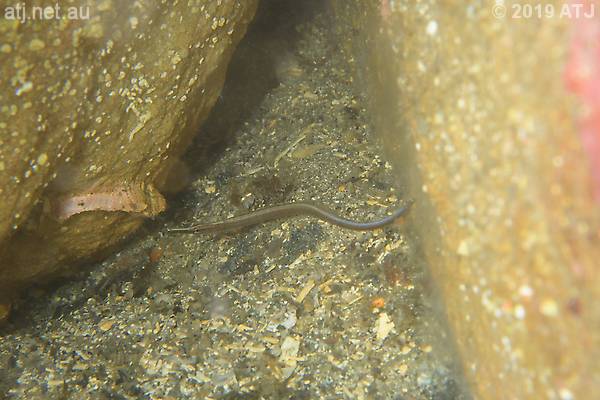
Sawtooth Pipefish, Maroubra perserrata. 13.1m.
I headed along the sand line towards the exit and almost immediately spotted a Weedy Seadragon. I was pretty sure it wasn't the same male from the start of the dive even though it had an appendage on its snout.

Weedy Seadragon, Phyllopteryx taeniolatus. 12.6m.
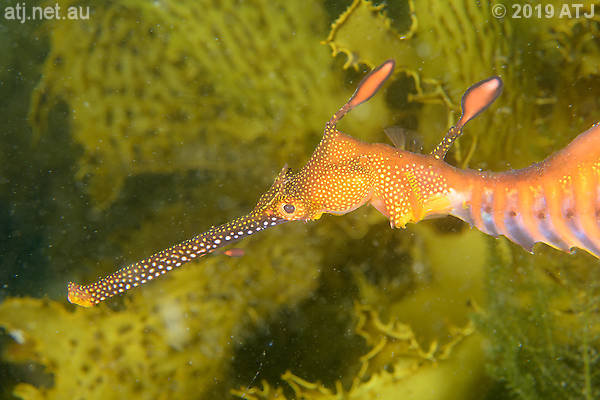
Weedy Seadragon, Phyllopteryx taeniolatus. 12.4m.
I now wanted to find the male I'd seen earlier to be sure. I continued along the sand line until I found him. Not only did I confirm that the the one I'd just seen was a different individual but he now had eggs! He didn't have eggs 80 minutes ago.
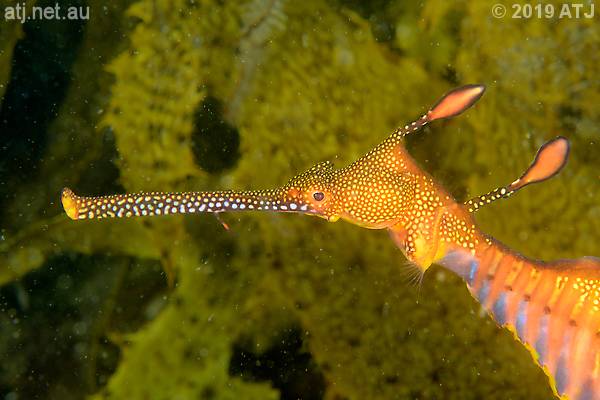
Weedy Seadragon, Phyllopteryx taeniolatus. 12.1m.
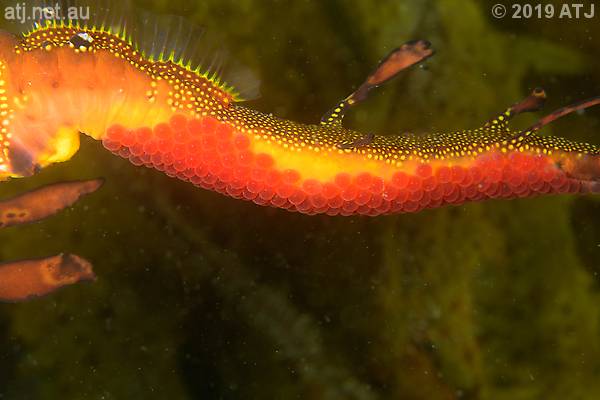
Eggs on the tail of a male Weedy Seadragon, Phyllopteryx taeniolatus. 12.3 m.
I was now very low on air and didn't have time to look for the female who'd be nearby. I headed straight up the reef towards the boulders and ascended to 5 metres and started my safety stop. I was very close to Split Rock when I got to 5 metres and bumped into Dom and Dimitry who were also doing their safety stop. Dom pointed out a large ray that was swimming by just above us.
I finished my safety stop and swam underwater to the exit. Dom grabbed my camera for me as I got out.
Camera gear
Camera
Nikon D500
Lens
Nikon AF-S Micro Nikkor 60mm f/2.8G ED
Housing
Ikelite 6812.5
Lens port
Ikelite Flat Port 5502.41
Strobe(s)
2 x Ikelite SubStrobe DS161